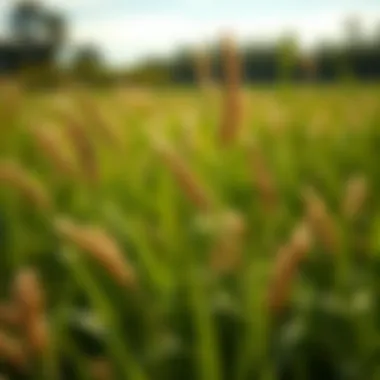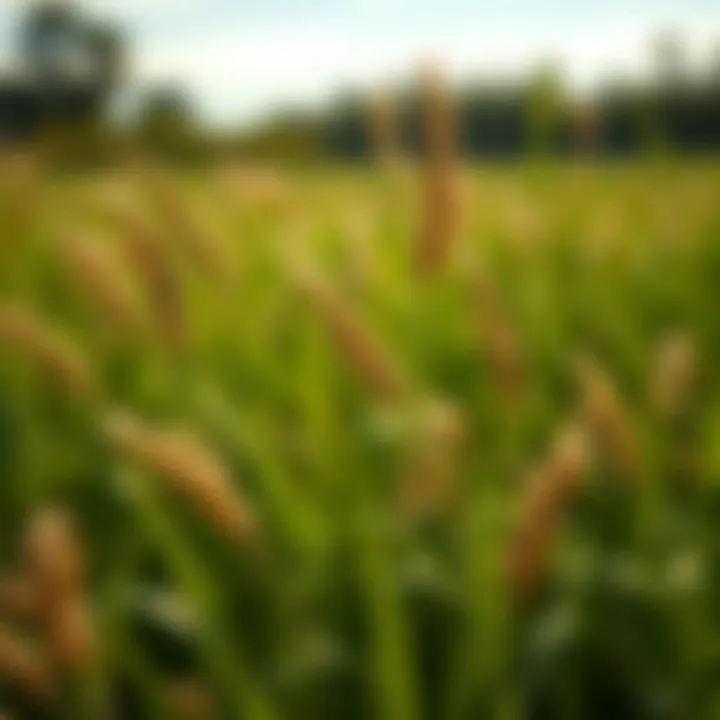Best Grass for Hot Weather: A Complete Guide


Intro
Selecting the right grass for hot climates is crucial for maintaining a vibrant and healthy lawn. In regions where the sun blazes down relentlessly, understanding the specific characteristics of various grass types can make all the difference. From the resilience displayed by Bermuda grass to the sustainability of Zoysia, different varieties come with their unique benefits, care routines, and adaptability traits. This guide will navigate through essential concepts, recent trends, and practical applications surrounding heat-resistant grasses, catering to both professionals in agriculture and enthusiastic homeowners.
Key Concepts and Terminology
Basic Definitions
Understanding some key terms can help in making informed decisions:
- Heat Tolerance: The ability of a grass type to withstand high temperatures without significant decline in health.
- Drought Resistance: Refers to the capacity of grass to survive with little water, essential for arid climates.
- Dormancy: A state where grass slows down growth in response to extreme heat or drought, allowing it to conserve water.
Historical Context
Grass types have evolved over centuries, adapting to varying climatic conditions. Traditional lawn grasses often thrived in cooler regions. However, as the demand for sustainable landscaping has surged, particularly in regions with higher temperatures, the interest in heat-resistant varieties has also gained traction. Notably, Bermuda grass became popular in the mid-20th century due to its robust nature and ability to thrive under the unforgiving sun.
Recent Innovations and Trends
Technological Advancements
Modern developments in grass breeding have led to the emergence of heat-resistant varieties that require less water and are more pest-resistant. Researchers now focus on traits like improved drought tolerance through crossbreeding and genetic modification. Notable examples include the development of smarter irrigation systems and soil sensors that help gauge when grass needs watering, minimizing waste without compromising growth.
Sustainable Practices
There’s a growing shift towards eco-friendly practices in lawn care. Many enthusiasts now prefer using native grass species, which naturally thrive in their specific regions without excessive input. Organic fertilizers and sustainable maintenance techniques bolster this trend, ensuring that lawns not only look good but also contribute towards a healthier ecosystem.
Practical Applications and Techniques
Step-by-step Guides
Starting a lawn with heat-resistant grass involves several key steps:
- Soil Testing: Assess soil type and pH to identify what grasses will thrive.
- Selecting Grass Type: Choose from varieties like Bermuda, Zoysia, or Buffalo grass based on your local climate.
- Preparation: Clear the area where the grass will grow. Test drainage and amend soil as needed.
- Seeding or Sodding: Depending on the grass type, either seed or lay sod. Follow specific guidelines for depth and spacing.
- Watering: Establish a routine, typically less often but deeper watering promotes root development.
- Maintenance: Regular mowing, fertilizing, and monitoring for pests is critical to keep the lawn flourishing.
Case Studies
In regions like Arizona, residents often opt for Bermuda grass during the hotter months. Successful implementations of Zoysia have been observed in the southeastern United States, where it thrives in humid, warm conditions and requires minimal watering once established. Homeowners there reported significant reductions in water usage along with lush, green lawns.
"Selecting the right grass isn't just about looks; it's about resilience and sustainability in face of the elements."
In summary, understanding what grass types deal best with heat and drought is essential for creating and maintaining a lush lawn, particularly in regions plagued by soaring temperatures. With an array of knowledge and many practices at one's disposal, individuals can make choices that reflect both aesthetic desires and ecological responsibility.
Prelims to Heat-Resilient Grass
When it comes to maintaining a vibrant lawn in hot conditions, understanding heat-resilient grass is crucial for both amateurs and seasoned gardeners. The growing climate crisis makes it more essential to choose the right type of grass that can stand the heat without turning brown or wilting. This article aims to provide critical information on heat-resistant grass types, focusing on their adaptability, maintenance needs, and ecological rewards. By doing so, readers can make informed decisions and ensure that their green spaces thrive even during the most blistering summer months.
Understanding the Need for Heat-Resistant Grass
As temperatures rise, many traditional grass varieties struggle to survive the heat, leading to disappointment for homeowners and agricultural practitioners alike. Heat-resistant grasses not only thrive under these conditions but also offer significant environmental benefits. The increasing frequency of droughts and water restrictions places added pressure on gardeners to choose sustainable but beautiful landscaping options. Not every turf can withstand dry summers and extreme weather fluctuations, which is why knowledge of heat-resistant varieties is essential.
Some key benefits of heat-resistant grasses include:
- Drought Tolerance: Grasses like Buffalograss and Zoysiagrass have deep root systems that tap into moisture below the surface, allowing them to survive longer without water.
- Reduced Maintenance: These grasses require less frequent mowing and watering, translating into time and money saved. They’re the practical choice for busy homeowners.
- Biodiversity Support: Choosing native or adapted grasses promotes local ecosystems, supporting various wildlife that thrives in arid conditions.
The Science Behind Grass Growth in High Temperatures
The biology of grass growth in high temperatures is fascinating. Grasses such as Bermudagrass and Zoysiagrass have evolved to thrive in warm climates. They have developed several physiological adaptations that allow them to withstand stressful conditions. For instance, these species often exhibit C4 photosynthesis, a process that is more efficient in hot environments. This mechanism enables them to convert sunlight into energy, even when water is scarce, making them exceptional contenders for hot climates.
Factors influencing the growth of heat-resistant grass also include:
- Soil Composition: The type of soil affects the grass's ability to access necessary nutrients and water. Sandy soils, for example, drain quickly but are often poor in nutrients, whereas loamy soils retain water better.
- Sun Exposure: Grasses thrive when they receive adequate sunlight, but extreme heat can lead to overheating. Shadier areas may require different grass types that tolerate lower light and less heat.
- Environmental Stress: Heat-stressed grass may become susceptible to pests and diseases. Understanding the signs of stress can prevent larger issues and help maintain a healthy lawn.
In summary, heat-resistant grasses are key to cultivating sustainable green spaces, especially in areas prone to drought and extreme weather. They present a practical solution to today’s ecological challenges, enhancing both our gardens and the environment.
In the upcoming sections, we will further explore specific grass types, their characteristics, and practical tips for establishing and maintaining a lawn that thrives in hot climates.
Evaluating Grass Types for Heat Tolerance


In regions where the sun bakes the earth and the soil can turn as hard as a rock, choosing the right type of grass becomes critical. Evaluating grass types for heat tolerance isn't just some garden whim, it's akin to laying the foundation for a sturdy house. This section sheds light on why understanding grass varieties is essential, particularly in areas that struggle with elevated temperatures and sparse moisture.
Selecting heat-resistant grasses can mean the difference between a vibrant lawn and an arid patch of land that resembles more of a desert than a lush green space. The right choice not only ensures aesthetic appeal but also addresses vital environmental factors, resilience to drought, and overall sustainability. Here are a few key considerations:
- Adaptability: Some grasses handle the heat like pros while others wilt under the pressure. Knowing which grasses thrive can save you time, money, and a whole lot of grief down the line.
- Maintenance Requirements: Different grasses come with varying demands in terms of watering, mowing, and fertilizing. Understanding these needs helps in managing them effectively.
- Environmental Impact: Choosing native grasses or those suited to your climate can enhance your local ecosystem, improving soil health and conserving water.
By evaluating the strengths and weaknesses of various grass types, you can make an informed decision that not only fits your personal aesthetic but also nurtures the environment.
Perennial Grasses: A Long-Term Investment
Perennial grasses are the heavyweights when it comes to heat tolerance, earning their stripes through years of resilience. Unlike annual varieties, which sprout and die within a single season, perennials return year after year, providing a reliable green carpet through the sweltering months. Their root systems tend to be deeper, allowing them to access water and nutrients nestled further below the surface.
This long-term investment comes with specific advantages:
- Durability: Once established, perennials like Zoysiagrass or Buffalograss can withstand drought conditions, cutting down your upkeep time significantly.
- Cost-Effectiveness: Lasting years reduce the need for re-seeding or wastage while lending a more consistent appearance to the lawn.
- Soil Health: Their roots contribute organic matter to the soil, enhancing fertility and structure over time.
For anyone committed to cultivating a robust lawn that can withstand the scorching summer sun, perennial grasses could be the ticket.
Annual Grasses: Quick Solutions for Immediate Needs
Annual grasses may not stick around for the long haul, but they have their own charms, particularly when you need a fast fix. Whether you're gearing up for an outdoor gathering or trying to establish ground cover in a new area, these grasses can sprout quickly and give you that immediate green boost.
Some advantages of opting for annual grasses include:
- Speed of Establishment: They usually germinate faster, allowing you to achieve a green lawn in a matter of weeks rather than months.
- Low Commitment: Great for temporary solutions, they can be a refreshing touch of green without the long-term upkeep.
- Variety: There are numerous types of annual grasses, such as Ryegrass and Foxtail, catering to various climates and preferences.
However, one must be mindful. Being short-lived means you’ll need to re-seed regularly, posing a higher maintenance load. Weighing these pros and cons is crucial in figuring out if these grasses suit your immediate landscaping needs.
Top Grasses for Hot Climates
Selecting the right type of grass for hot climates is not simply a matter of aesthetic appeal; it is an integral step towards cultivating a vibrant, resilient lawn that thrives under the sun. The significance of this topic lies in understanding that specific grass varieties can withstand high temperatures, conserve water, and reduce the need for frequent maintenance. This guide will unveil key grasses that not only survive but also flourish in arid conditions, providing essential benefits such as drought-tolerance and low upkeep requirements. Let's dive deeper into some of these options.
Bermudagrass: The Dominant Choice
Bermudagrass has long been held as the gold standard for warm climates, often hailed for its vigorous growth and resilience. This perennial grass is a native to Africa and has spread globally, establishing itself as a favorite across southern United States and similar environments. Its fine texture and rich green color make it visually appealing, but don’t let that fool you—this grass can take a beating.
- Heat Tolerance: Bermudagrass can withstand high temperatures with ease, maintaining its lush appearance even when the mercury rises. It's an ideal choice for homeowners looking for a lawn that can endure sweltering summers.
- Drought Resistance: Once established, Bermudagrass performs admirably with less water compared to other types. This quality makes it a go-to for those conscious about conserving resources.
- Quick Establishment: Bermudagrass germinates swiftly, making it suitable when you need a quick grass solution. Typically, expect results in just a few weeks after planting.
However, while this grass thrives in sunny conditions, it requires some care, particularly during the establishment phase and through the growing season. Regular mowing helps it reach its full potential, pushing it to a thicker, tougher lawn.
Buffalograss: A Drought-Tolerant Option
Buffalograss stands as an exemplary drought-tolerant choice that thrives in hot and dry climates. Originating from the Great Plains of the United States, it's well-known for its ability to handle neglect while still looking sharp. This native grass is tough yet surprisingly soft underfoot, making it ideal for residential and commercial landscapes alike.
- Low Maintenance: One of the biggest advantages of Buffalograss is that it requires minimal care once established. It needs far less water compared to other grasses, sometimes requiring no irrigation at all!
- Eco-Friendly: Choosing Buffalograss can also contribute positively to the environment. Since it’s adapted to arid climates, it typically attracts native wildlife, promoting a thriving ecosystem.
- Cost Efficiency: With its low water needs and reduced mowing frequency, homeowners can save significantly on their water bills and maintenance costs.
For those in the right climate zone, Buffalograss can bring a vibrant green landscape that helps conserve the environment just as much as it does your wallet.
Zoysiagrass: Versatile and Resilient
Zoysiagrass is often celebrated for its versatility and ability to adapt to a variety of conditions. While it can handle heat, it also withstands shade better than its warm-season counterparts, making it an appealing option for properties with varying sunlight conditions. Its thick growth helps it choke out weeds, a plus for many homeowners.
- Durable Growth: Zoysiagrass can tolerate both foot traffic and varying weather patterns, making it great for lawns and recreational areas. A solid option for families that enjoy outdoor activities, its resilience promotes long-term health.
- Aesthetic Appeal: Its dense growth forms a lush carpet-like surface that’s soft to walk on, with an attractive dark green hue. This grass connects the utility of heat resistance with visual appeal.
- Adaptability: Whether in a dry area or a spot that sees some shade, Zoysiagrass has shown it can adapt, making it one of the more versatile grass options.
While Zoysiagrass does grow slower in cooler temperatures, its overall resilience and adaptability will reward you over time.
Establishing Your Lawn: A Step-by-Step Guide
Having a green lawn is more than just a matter of aesthetics; it’s about creating a vibrant environment that can withstand the rigors of heat. Establishing your lawn properly sets the foundation for a healthy grass ecosystem. When you have the right approach, you not only promote growth but also minimize the impacts of weeds, pests, and diseases. This section will guide you through the essential steps of establishing your lawn, ensuring success in heat-prone areas.
Preparing the Soil for Grass Seed
Before you can lay down the grass seeds, it’s crucial to prepare the soil. Think of soil as the bedrock of your lawn. A healthy soil structure can hold onto moisture and nutrients effectively. The first thing you want to do is clear the area of weeds, rocks, and debris. If you don’t, those pesky weeds will suck up resources meant for your new grass.
Next, check the soil pH. Most grasses prefer a pH between 6.0 and 7.0. You can purchase a soil testing kit from your local garden store, or sometimes you can find them online to get the grit on what your soil needs. If your soil is too acidic, you might need to add lime, or if it's too alkaline, sulfur can help bring it back to balance. Furthermore, consider spading or tilling the soil to aerate it, allowing air and nutrients to permeate more easily.
"Healthy soil means healthy grass."


Once you have done this, adding organic matter like compost not only improves soil texture but also encourages earthworms, which further enhances soil richness. Mix in a layer of compost while tilling. This sets you up for long-term success.
Choosing the Right Time for Planting
Timing can be everything when it comes to sowing grass seed. Planting too early or too late can lead to failures that leave you frustrated and out of pocket. As a general rule, the best time to plant heat-resistant grasses is during the late spring, when temperatures consistently reach above 65°F (about 18°C). This allows the seedlings to establish themselves before the peak heat rolls in.
Another element to consider is rainfall. Make sure you check the forecast ahead of time. If a big downpour is expected, planting just before it can help give your seeds a smooth start. And, if you’re in a particularly dry area, planting earlier in the morning or later in the evening can help support better germination rates since the sun won’t be bearing down on newly sown seeds.
Seeding Techniques for Maximum Germination
Now that your soil is ready and you’ve timed your planting just right, it’s time to get to the seeding part. Depending on the size of your lawn, you might want to sow the seeds by hand or with a seed spreader. A seed spreader helps evenly distribute the seeds, minimizing clumping that can lead to patchy growth.
When seeding, think of creating a “checkerboard pattern”; it helps maximize coverage. Once you’ve spread the seeds, lightly rake the area to ensure they’re nestled down into the soil, which aids in moisture retention and prevents birds from snatching the seeds up.
Afterward, water the area lightly but thoroughly. It’s essential to keep the soil moist, but you don’t want to create puddles. You may need to water every few days until the seeds germinate, at which point you can transition to a regular watering schedule.
Your efforts here will pay off significantly as a lush lawn starts to emerge, resilient to those hot summer days ahead.
Maintenance Practices for Heat-Resistant Grasses
Caring for heat-resistant grasses goes beyond simple seeding and watering. It requires a nuanced approach that takes into account the environmental conditions, grass type, and long-term investment in lawn health. Proper maintenance not only encourages a resilient lawn but can also enhance its aesthetic appeal and ecological benefits. Structuring maintenance practices wisely can lead to a vibrant, thriving turf that remains pleasant to look at, even in the sweltering summer months.
Watering Strategies for Hot Weather
Watering is perhaps one of the most critical aspects of maintaining heat-resilient grasses. In high temperatures, grasses are prone to stress. A well-planned watering strategy can mitigate these issues effectively.
- Deep Watering: Rather than lightly wetting the lawn several times a week, aim for fewer sessions but increase the water amount. Watering deeply encourages roots to grow downwards, searching for moisture.
- Timing Matters: Early morning is hands down the best time for watering. It reduces evaporation and allows grass blades to dry well before nightfall, minimizing disease risk.
- Use a Soaker Hose or Irrigation System: These tools can distribute water evenly across the lawn. They minimize runoff and evaporation, ensuring that this vital resource reaches the roots.
"Watering effectively is not just a chore; it's an art. You're sculpting the health of your lawn right from the start."
Mowing Techniques to Enhance Growth
Mowing is more than just keeping the grass trimmed; it’s about encouraging healthy growth. Heat-resistant grasses, in particular, respond positively to proper mowing techniques.
- Height Matters: Keep the grass a bit taller during the hotter months. Longer blades provide shade to the soil and roots, thus reducing moisture loss and keeping temperatures lower at ground level.
- Sharp Blades: Always mow with sharp blades to prevent tearing the grass. Torn edges can lead to a greater risk of disease, especially when grass is stressed from high temperatures.
- Alternate Mowing Patterns: Changing the direction you mow can help the grass grow upright and discourage soil compaction.
Fertilization Tips for Optimal Health
The right fertilization techniques significantly contribute to a healthy lawn, especially in challenging heat conditions. Selecting the appropriate fertilizer and timing its application are essential.
- Use Slow-Release Fertilizer: Instead of quick-release options that can burn the grass, slow-release fertilizers provide essential nutrients over a longer period, giving the grass time to absorb without stress.
- Timing Your Fertilization: Apply fertilizer in early spring or fall when temperatures are milder. Doing so allows the grass to utilize nutrients away from peak heat stress.
- Consider Soil Tests: Understanding your soil's nutrient composition can guide you in applying precise amounts of fertilizer, thus optimizing growth without overdosing.
In summary, the commitment to maintaining heat-resistant grasses pays off in many ways—enhanced lawn health, reduced water consumption, and the promotion of a more sustainable environment. A well-maintained lawn isn’t just pretty; it serves a bigger purpose in promoting a healthy ecosystem.
Common Issues with Heat-Resilient Grasses
The selection of heat-resistant grass is only half the battle; maintaining it in conditions rife with challenges is the other. When navigating hot climates, it’s vital to address the issues that can undermine your efforts, including pests, weeds, and diseases. Each of these problems can wreak havoc on even the most resilient grass types, turning lush greenery into distressed patches. Knowing how to identify and combat these common threats will empower you to keep your lawn thriving despite harsh conditions.
Identifying and Addressing Pests
Pests are a constant worry for any grass-loving enthusiast. For instance, grubs and chinch bugs can quietly destroy the robust roots of heat-resistant grasses like Bermudagrass and Zoysiagrass. Identifying these pests early is crucial to nipping the problem in the bud. Look for signs like browned patches or sections of grass that seem to be wilting or floating.
When faced with an infestation, options abound for addressing them:
- Chemical treatments: Pesticides tailored for specific critters can be effective, but savvy application is needed to avoid harming beneficial insects.
- Natural remedies: Introducing predatory insects or concocting homemade pest repellents with simple ingredients can keep unwanted visitors at bay.
- Cultural practices: Regular lawn care, like proper watering and mowing habits, can make your grass less appealing to pests.
Dealing with Weeds in a Heat Environment
Weeds cause headaches in any lawn care routine, and hot weather makes them particularly tenacious. With their ability to outlast drought, these pesky invaders can drain resources from your beloved grass. To tackle this issue, start with prevention. A thick layer of mulch or a robust lawn can help minimize weed growth before it starts.
Should unwanted plants emerge, consider the following strategies:
- Hand-pulling: For smaller weed populations, pulling them out by the roots is often effective.
- Mulching: A layer of organic mulch can suppress growth while enhancing soil quality.
- Herbicides: Selective herbicides are beneficial but must be used judiciously to protect your heat-tolerant grasses. Always follow label instructions for best results.
Preventing and Treating Diseases
Even heat-resistant grasses aren't immune to diseases that thrive under warm, humid conditions. Fungal infections, such as dollar spot or brown patch, can spread like wildfire in a lawn that's struggling. Recognizing symptoms is essential. Brown patches or splotchy areas merit immediate attention.


To manage diseases effectively:
- Practice good lawn hygiene: Regularly raking leaves and clippings can reduce the potential for fungal growth.
- Ensure proper watering techniques: Watering in early morning or late afternoon rather than at night helps grass dry quickly, minimizing diseases’ foothold.
- Fungicides: Available treatments can be potent, but their application should be done thoughtfully, considering the environment and potential water runoff.
"An ounce of prevention is worth a pound of cure."
By embracing these practices and keeping an eye out for pests and diseases, you can ensure your heat-resistant grass thrives even in the hottest of climates.
Environmental Benefits of Choosing Heat Tolerant Grass
Choosing heat-tolerant grass varieties goes beyond just maintaining a vibrant lawn; it reflects a conscious decision towards environmental sustainability. In the face of climate change, where rising temperatures and irregular rainfall patterns are increasingly common, selecting the right grass type can have significant ecological implications. Here are three core benefits:
Enhancing Soil Health
Heat-resistant grasses often possess deep root systems that help in anchoring the soil. This prevents erosion, especially during dry spells. Additionally, these grasses contribute organic matter to the soil as they grow and decay, enriching the nutrient profile. For instance, Bermudagrass and Zoysiagrass, known for their heat endurance, can effectively improve soil aeration and structure.
- Benefits of Soil Enrichment:
- Retention of moisture, allowing deeper water infiltration.
- Increased microbial activity that promotes natural fertilizer production.
- Reduction in the need for chemical fertilizers, which can run off and pollute waterways.
By nurturing the soil, heat-tolerant grasses create a mutually beneficial ecosystem that sustains both plant life and soil health, paving the way for more robust agricultural practices.
Promoting Biodiversity
A diverse plant ecosystem mimics nature's own design, which is particularly important in agricultural settings. Using heat-resistant grasses encourages a broader variety of life forms—this can attract beneficial insects, birds, and other wildlife. In essence, growing plants that can withstand heat allows for a variety of ecosystems to flourish:
- Key Points on Biodiversity:
- Habitats for Beneficial Insects: Heat-resilient grasses can serve as a habitat for insects that are vital for pollination, which in turn boosts crop yields.
- Wildlife Support: Native species often thrive alongside heat-tolerant varieties, promoting a more stable ecosystem.
- Genetic Diversity: By planting multiple species of grass, farmers can create resilience against diseases and pests that might impact single-crop systems.
A flourishing biodiversity not only helps maintain natural balance, but it also enhances the resilience of agricultural systems against changing climatic conditions.
Conserving Water Resources
One of the pressing challenges in agricultural practices today is water scarcity. Heat-resistant grasses typically require less water compared to standard turf grasses. Their ability to survive with minimal irrigational support means that farmers can utilize their precious water resources more effectively:
- Water Conservation Strategies:
- Indigenous Varieties: Selecting grasses such as Buffalograss not only requires less irrigation but can also adapt to local rainfall patterns, making them a smart choice for water-conscious farmers.
- Reduced Evapotranspiration: The dense foliage of heat-tolerant grasses limits water loss through evaporation, ensuring that roots remain nourished even during dry spells.
In summary, by opting for heat-tolerant grass varieties, farmers can significantly contribute to the conservation of our precious water resources while maintaining healthy landscapes.
The environmental benefits of these grasses are not just limited to soil health or resource management; they extend into promoting a vibrant ecosystem that supports agricultural integrity and sustainability. As we continue to explore the optimal grass types for hotter climates through this guide, the advantages of selecting heat-durable grass underscore the compelling need for thoughtful lawn choices.
Closure: Making Informed Choices
Selecting the appropriate grass type for areas enduring high temperatures is no small feat. An informed choice can shape not only the aesthetic appeal of your lawn or field but also the long-term sustainability of your efforts in maintaining it. Each grass type discussed in this article comes with unique characteristics that cater to different needs. Understanding the balance between heat tolerance, maintenance demands, and the environmental impact will guide you toward a successful decision.
First and foremost, recognizing that heat-resilient grasses like Bermudagrass, Buffalograss, and Zoysiagrass thrive under specific conditions is crucial. These grasses are engineered by nature to withstand arid environments, making them well-suited for climates where traditional grass struggles to survive. When you choose the right grass, you effectively reduce the need for excessive water, fertilizer, and pesticides, all of which can strain both your wallet and natural resources.
Additionally, selecting heat-tolerant options helps in conserving water resources—a pressing concern in many regions due to climate change. By opting for these alternatives, you’re not just creating a lush lawn but making an ecological statement. This decision impacts biodiversity, enhances soil health, and promotes a more sustainable environment overall.
Key takeaway: The right grass selection benefits both you and the ecosystem.
While this article highlights various grasses and their benefits, it also points out that making a choice involves considering your local climate, soil type, and specific maintenance capabilities. Each factor plays an important role in determining the best fit for your needs.
Summarizing Key Points
To encapsulate the core of this guide, here are a few key points to remember when selecting grasses for heat:
- Assess Local Climate: Understand the typical temperature ranges and rainfall patterns in your area.
- Evaluate Grass Types: Choose from Bermudagrass, Buffalograss, Zoysiagrass, and others depending on your lawn's specific needs.
- Maintenance Needs: Consider how much time and resources you are willing to invest in upkeep.
- Environmental Impact: Opt for grasses that conserve water and promote healthier ecosystems.
- Long-Term vs. Short-Term: Weigh the benefits of perennial grasses against the quicker germination of annuals.
Future Considerations in Grass Selection
As temperatures continue to rise globally, looking ahead is essential. Future grass varieties may be developed with even greater heat resistance and drought tolerance. Keeping up with advances in agricultural science can open the door to newer breeds that are more resilient and easier to manage.
Incorporating genetic advancements or hybrid varieties could provide flexibility for homeowners and farmers alike. Moreover, consider soil health as an evolving component. Practices that enhance soil integrity will become increasingly important for grass sustainability in the coming years.
Ultimately, as environmental conditions shift, your ability to adapt grass selections accordingly will determine the success and sustainability of your landscape. Stay informed about new research, local climate changes, and innovative watering techniques that could match your grass choices.
Utilize online resources like Wikipedia or Britannica for further reading. Engaging with community forums such as Reddit or local agricultural extensions (e.g., *.edu or *.gov) can provide practical insights and tips from people already navigating the challenges of heat-resilient grasses.
By making choices now that consider both present circumstances and future possibilities, you are on the right path to cultivating a vibrant, sustainable lawn that thrives, irrespective of the elements.















